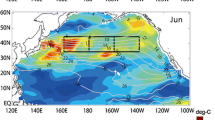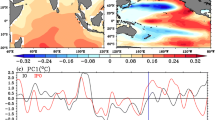Abstract
Heat content anomalies are analyzed to understand subsurface variability on both aparticular focus on the evolving basinwide patterns and oceanic connections between the extratropics and tropics. Various analyses indicate two distinct modes, one interannual and the other decadal, that involve the tropics and the North Pacific subtropical gyre, respectively. Interannual variability is associated with El Niño in the tropics, with a prominent “see-saw” pattern alternately on and off the equator, and in the east and west, respectively. The interannual cycle features a coherent propagation of subsurface signals around the tropical Pacific, eastward along the equator but westward off the equator at 10–15 °N. Decadal signals are dominant in the subtropics and midlatitudes but also have a tropical component that appears to be independent of interannual variations. An oceanic connection can be seen between subsurface anomalies in the midlatitudes, in the subtropics and tropics on decadal time scales. Subsurface thermal anomalies associated with midlatitude decadal variability can propagate through the subtropics into the tropics, which may modulate the intensity of interannual variability in the tropics. For example, in the middle and late 1970s, a significant warm temperature anomaly appeared to penetrate into the western and central tropics at depth, warming the tropical upper ocean and depressing the thermocline. During the development of El Niño, therefore, an extratropically preconditioned subsurface state (e.g., an enhanced positive heat content anomaly) in the western and central tropical Pacific would favor a warmer sea surface temperature anomaly in the eastern equatorial Pacific, potentially increasing the intensity of ocean-atmosphere coupling. These changes in the thermocline structure and possibly in the coupling strength can further alter the very character of tropical air-sea interactions. This may help to explain decadal variability of El Niño evolution in the tropical Pacific as observed in the 1980s. Our subsurface variability analysis presents observational evidence for the detailed space-time structure of decadal oceanic links between the extratropics and the tropics.
Similar content being viewed by others
Author information
Authors and Affiliations
Additional information
Received: 16 January 1998 / Accepted: 8 September 1998
Rights and permissions
About this article
Cite this article
Zhang, RH., Rothstein, L. & Busalacchi, A. Interannual and decadal variability of the subsurface thermal structure in the Pacific Ocean: 1961–90. Climate Dynamics 15, 703–717 (1999). https://doi.org/10.1007/s003820050311
Issue Date:
DOI: https://doi.org/10.1007/s003820050311




